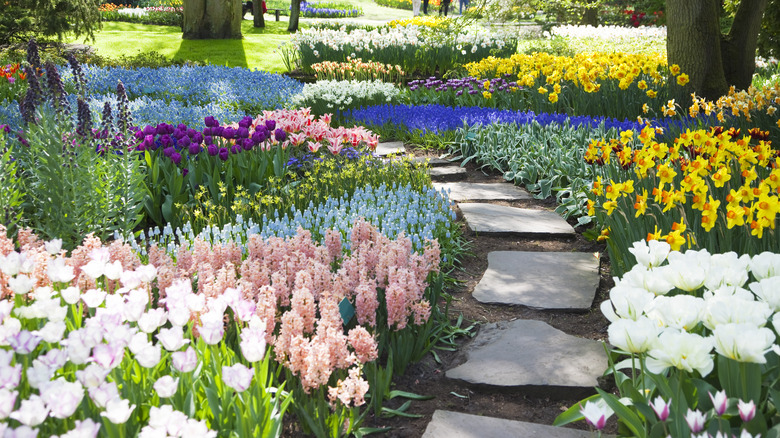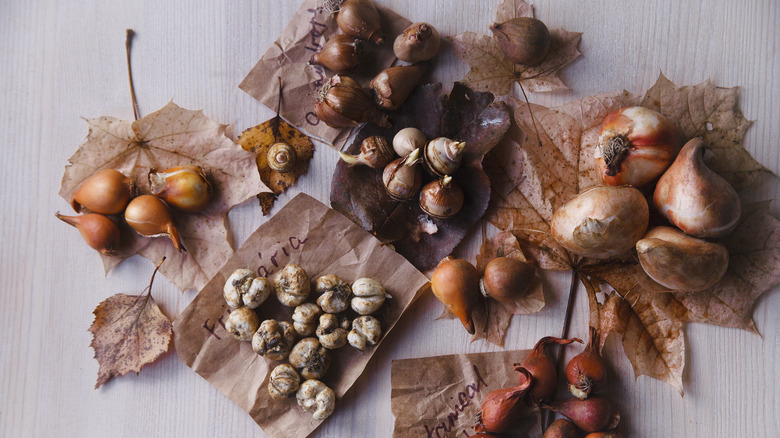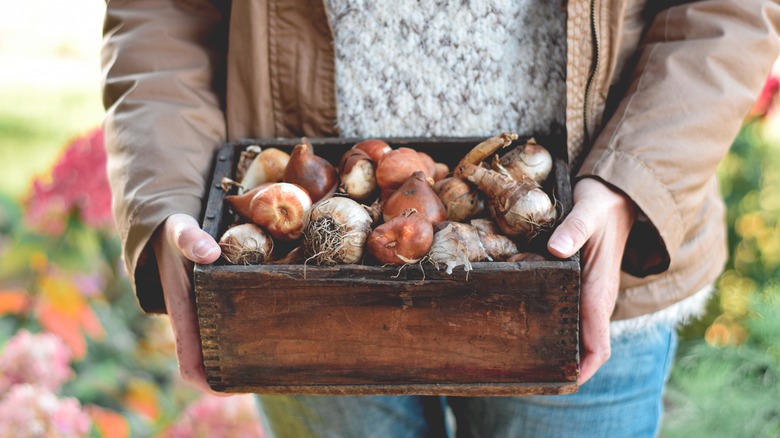Helping Spring Bulbs Bloom Is Easier Than You Think With This Gardening Hack
Bulb flowers are a beloved staple in many gardens, adding vibrant splashes of color and beauty when they bloom. Tulips, daffodils, hyacinths, and crocuses are just a few examples of the plethora of bulbs cherished by gardeners worldwide. However, if you live in a place with a warmer climate, cultivating spring-blooming bulbs can present a challenge. Many of these bulbous plants require a period of cold dormancy to thrive, mimicking the winter conditions of their native habitats. Without this essential dormant period, bulbs may fail to develop properly or may not flower at all. This can be disheartening if you're a gardening enthusiast longing to enjoy the beauty of these blooms in your own yard. Fortunately, there's a solution you can try: refrigerating flower bulbs until they are ready for planting in the spring or end of autumn.
Chilling bulbs in the refrigerator offers several advantages beyond ensuring successful cultivation in warmer climates. It can extend bloom time by delaying the emergence of foliage and flowers. This way, you can stagger the flowering period, providing a more prolonged display of blooms in your garden. Refrigerating bulbs also allows gardeners in regions with inconsistent or mild winters to adapt plants to their local climate. By providing the necessary cold period artificially, gardeners can cultivate a broader range of bulbous plants that may not naturally thrive in their area.
Proper refrigeration techniques for flower bulbs
Refrigerating flower bulbs is a simple yet effective method to ensure successful cultivation, even in warmer climates. Make sure you select healthy, high-quality bulbs that are firm and free from mold or rot. Bulbs that are damaged or soft may not fare well in the refrigerator or storage in general. Most flower bulbs require a period of cold temperatures between 35 and 45 degrees Fahrenheit for several weeks to simulate winter dormancy. A refrigerator's vegetable drawer or a dedicated bulb fridge can provide the ideal environment. Place bulbs in a breathable container, such as a paper bag or a mesh bag. However, as gardening expert Yolanda Vanveen advises in an ehowgarden video on YouTube, bulbs like lilies may dry out when placed in a paper bag. Instead, you can add some soil (slightly moist) alongside the lily bulb in an airtight plastic bag before chilling it.
Refrigerating bulbs with fruit or vegetables is not recommended, primarily due to ethylene gas emissions. Certain fruits and vegetables release ethylene gas, a natural plant hormone, as they ripen. The ethylene gas exposure of bulbs can disrupt their natural growth cycle, leading to distorted or stunted growth. To ensure the best outcomes for bulb storage, it's essential to store them separately from fruits and vegetables in a dedicated area of the refrigerator.
How long to refrigerate different types of bulbs
The duration of refrigeration varies depending on the type of bulb. Tulip bulbs typically require a chilling period of about 12 weeks. This extended period ensures proper development and flowering once planted in the spring. Daffodil bulbs typically need a chilling period of 12 to 14 weeks. However, some varieties may require shorter or longer chilling times, so it's essential to check the specific requirements for the variety you have. Hyacinth flower bulbs usually require a chilling period of 10 to 12 weeks. As with daffodils, there may be variations in hyacinth bulb chilling requirements depending on the variety.
To be sure, check the specific recommendations for each type and variety of bulb. Factors such as bulb size, storage conditions, and climate can also influence the duration of refrigeration needed. Periodically inspect your stored bulbs to ensure they remain firm and healthy, and discard any that show signs of decay or mold.
Alternatives to refrigeration include planting bulbs directly into the ground and mulching heavily to simulate cold conditions, or purchasing pre-chilled bulbs from nurseries. However, refrigerating flower bulbs is a known reliable method for ensuring successful cultivation, allowing gardeners in warmer climates to enjoy the beauty of these beloved blooms year after year.


